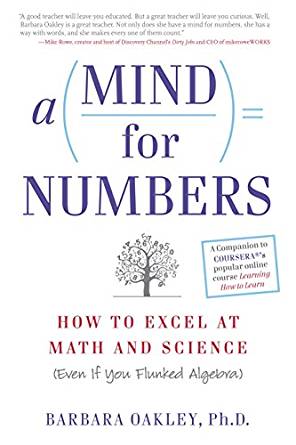A Mind for Numbers Summary

4 min read ⌚
 How to Excel at Math and Science (Even If You Flunked Algebra)
How to Excel at Math and Science (Even If You Flunked Algebra)
We know, we know – math is not exactly something you’re too keen on. Well, guess what – the same holds true for millions of people!
However, Barbara Oakley thinks that she can change your mind. And make you so much better at it! Time for her “A Mind for Numbers”!
About Barbara Oakley
 Barbara Oakley (born Barbara Ann Grim) is a Professor of Engineering at Oakland University. Dubbed the “female Indiana Jones,” she is an adventurer both in her life and her writing.
Barbara Oakley (born Barbara Ann Grim) is a Professor of Engineering at Oakland University. Dubbed the “female Indiana Jones,” she is an adventurer both in her life and her writing.
Captain in the US Army, she has worked as Russian translator and radio operator in Antarctica, and has written/edited numerous books on various subjects, ranging from biology (“Evil Genes”) to psychology (“Pathological Altruism”) and self-help techniques (“Mindshift”).
“A Mind for Numbers Summary”
One of the first things you realize at school is that not everyone is capable of understanding math. Some, you fathom quite quickly, are simply better at learning math than the others.
However, Barbara Oakley says that that’s only one of the ways you can look at things. The other – as she states in the title of her brilliant “Coursera” course – is to start learning how to learn math and science.
And in “A Mind for Numbers” she offers her readers numerous interesting tips and tricks.
For example, first of all you must realize that there are two different ways of thinking. Not fast and slow, but focused and diffused. You use the first one when you nitpick; the second one – to see the “big picture”.
However, both are essential. Consider, as evidence, the following sentence: “Thiss sentence has threee errors.” You’ll find the first two using your focused brain; for the third one – you need a more diffused method.
(We’ll let you think about it a bit: we reveal the error in our “Key Lessons” section.)
Now, the trick is to combine these two ways of thinking well: to think diffusedly when you start learning things, and in a focused manner when you specialize.
With many hours of sleep in-between!
Now that you get the “big picture” (ha, see what we did there?), let’s move on to the more specific techniques.
The first one is called chunking – and it’s the first and most essential part of any deep practice. It means – divide and conquer. That’s how the big becomes small, and the small becomes big once again after being tackled.
The next one is preventing procrastination. The best way to do this is to start focusing on the process instead of the outcome. Learn every day for, say, 1 hour – regardless of how much you’ll end up learning. That will help you relax, and you’ll actually end up learning more than in the case of stating an objective “I’ll learn this in 1 hour.”
Preventing procrastination is closely linked to another important aspect of your life: time management. Or, in other words: organize yourself!
Next on the agenda: memorization techniques. There are many out there, and they can help you become a memory champion even if you’re just an ordinary person.
Finally – be gritty!
Because, practice, persistence, and passion usually give better results than sheer intelligence. And studies have shown this over and over again.
Key Lessons from “A Mind for Numbers”
1. Learn How to Learn Math
2. There Are Two Modes of Thinking
3. Thiss Sentence Has Threee Errors
Learn How to Learn Math
Learning math is difficult. However, learning how to learn math is not. Which is funny – if you take into consideration that the latter is a prerequisite for the first.
“A Mind for Numbers” will not teach you math. It’s a book whose goal is to teach you how you can learn math. In time – you’ll excel at it all by yourself.
There Are Two Modes of Thinking
The key lesson of the book is that there are two ways to think about things. The first one is called focused thinking and it’s what you are able to do in areas which are within your field of expertise.
The second one, however, is diffused thinking – and it’s just as important as the first one. Especially, when you start learning something new. Because it helps you see the “big picture”
Thiss Sentence Has Threee Errors
You are probably reading this key lesson before the other two.
Why?
Because most of us are usually practicing focused thinking. And when we introduced you to this assignment above, using it, you were only able to see two mistakes – both of them spelling errors.
The third one, however, is the most obvious one: it’s logical. And you can deduce it by using the method of diffused thinking.
Namely: the sentence itself is not correct.
Like this summary? We’d like to invite you to download our free 12 min app, for more amazing summaries and audiobooks.
“A Mind for Numbers” Quotes
Thiss sentence contains threee errors. Share on X Attempting to recall the material you are trying to learn—retrieval practice—is far more effective than simply rereading the material. Share on X Focus on the process (the way you spend your time) instead of the product (what you want to accomplish). Share on X If you protect your routine, eventually it will protect you. Share on X Procrastination is like addiction. It offers temporary excitement and relief from boring reality. Share on X







